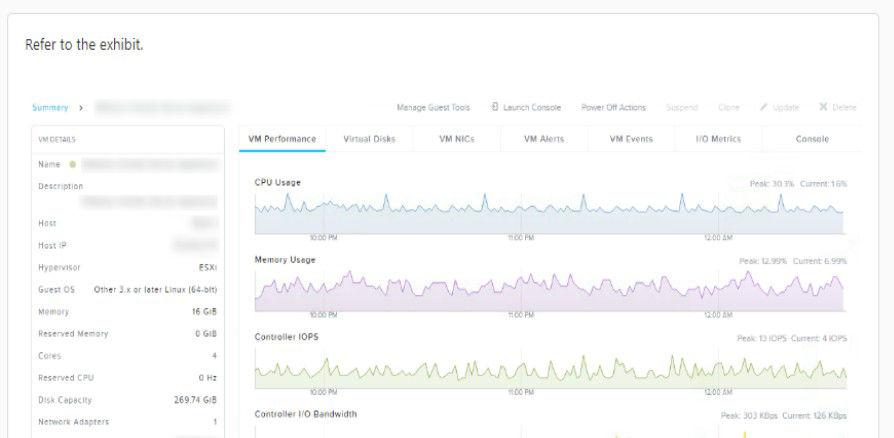| Page 4 out of 30 Pages |
What are two minimum prerequisites for live migration to succeed? (Choose two.)
A. All AHV hosts have IP addresses in the same subnet
B. All AHV hosts must be configured on the same VLAN
C. All VMs have an IP address in the same subnet
D. All VMs are configured for the same VLAN
A user is complaining about slowness of a mission-critical MSSQL Server. The
administrator logs into Prism Element to investigate the VM performance and observes
what is shown in the diagram.
Which action would best improve VM performance?
A. Disable hyperthreading in the BIOS.
B. Add additional RAM to the user VM.
C. Add additional RAM to the host on which the VM is running
D. Ensure the host's CPUs ere not excessively overcommitted
During an AHV upgrade, an administrator finds that a critical VM was powered off rather than migration to another host. Which scenario explains this behavior?
A. NO AHV hosts were able to be scheduled.
B. The VM OS hung during migration.
C. The VM was on the same host as the acropolis leader.
D. The VM was marked as an agent VM.
An administrator is preparing to deploy a new application on an AHV cluster, Security requirements dictate that all virtual servers supporting this application must be prevented from communicating with unauthorized hosts. Which option would achieve this goal?
A. Create a new VLAN, create a subnet on the cluster with the VLAN tag, deploy servers with vNlCs in the new subnet.
B. Create a new Application Security Policy restricting communication to the authorized hosts and apply it to the servers in enforce mode.
C. Create a new solation Environment policy apply it to the new servers and all authorized hosts.
D. Create new' subnet and assign to an existing VPC assign the IP prefix and gateway for the subnet, deploy servers with vNlC5 in the new subnet.
An administrator needs to deploy an application with a large amount of data connected via Nutanix volumes. Which two actions should the administrator take when designing the Volume Group? (Choose two.)
A. Distribute workload across multiple virtual disks
B. Enable RSS (Receive Side Scaling)
C. Use multiple subnets for iSCSI traffic
D. Enable thick provisioning on the Volume Group(s)
Which capability refers to the storage of VM data on the node where the VM is running and ensure that the read I/O does not have to traverse the network?
A. Intelligent Locally
B. Data Locality
C. Intelligent Tiering
D. Data Tiering
| Page 4 out of 30 Pages |
| Nutanix NCP-MCI-6.5 Practice Questions Home | Previous |